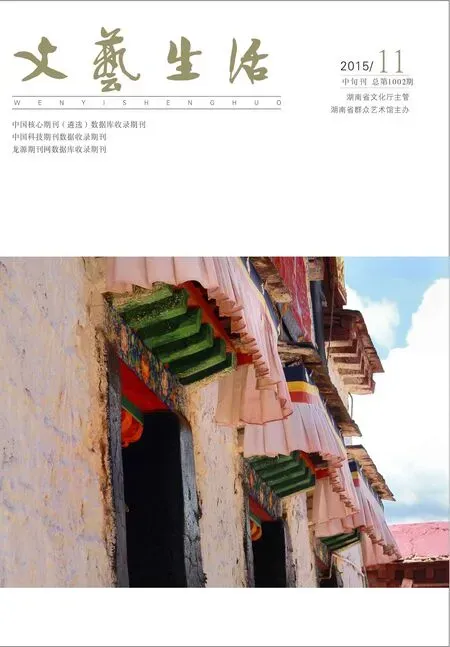Study on and Redefinition of the Concept of Culture
戴剑飞
(1.西南交通大学马克思主义学院,四川成都 610031;2.四川师范大学,四川成都 610068)
Study on and Redefinition of the Concept of Culture
戴剑飞1,2
(1.西南交通大学马克思主义学院,四川成都 610031;2.四川师范大学,四川成都 610068)
So far,various opinions about the concept of culture are come up with in both China and the West in which three kinds of culture are classified as follows.The culture in narrow sense denotes merely the ideas.The culture in medium sense embraces ideas,customs,norms,symbols and behaviors,etc.The culture in broad sense refers to the lifestyle constituted of both the material culture and spiritual culture.There is an urgent necessity to redefine the concept of culture by exploring the history of the etymology of the word"culture"in order to figure out the deviance of different concepts of culture.
Culture;Concept;Investigation
The proposal and classification of the concept of culture In 1871,the British cultural anthropologist Edward Taylor pointed out in the book“primitive culture”that,“the culture or civilization---is a complex bundle junction of all including knowledge,beliefs,arts, laws,morality,customs,the talents and habits that any other person can acquire”.This statement is considered to be the earliest special construction of the concept of culture in modern anthropology.From then on,the concept of“culture”has been widely adopted and the definition tends to emerge in endlessly.The concept of culture in narrow sense denotes merely the ideas as is stated by Blumenthal that“culture is the total of the concept of culture both in the past and present”;Besides ideas,the culture in medium sense also embraces customs,norms,symbols and behaviors,etc,while the material culture is not included.For example,Lowie (1937)believed that“the culture we know is the sum of a person’s acquisition from his society which include beliefs,customs,arts,food habits and handicrafts.“The concept of culture in broad sense refers to the lifestyle constituted of both the material culture and spiritual culture.As Sapir states that”Culture is constituted of all the elements derived from the society both in human’s material and spiritual life.
Investigation into the etymology of culture Concerning the divergence of the term“culture”,it is necessary to investigate its historical evolution.The term“culture”can be dated back to the origin of western culture–the ancient Greek,which bred terms like“trops (types)”,“ethos(temperament or spirit)”,“nomos(the varieties and variabilities of social statues)”and“piadeia(intelligence and education)”.The word“culture”,being created during the period when Romans inherited from ancient Greek,evolvedfrom the word“Colere”to“Cultus”,then to“Cultura”and“Culture”.The Latin word“Colere”originally means living,cultivation,protection and honor,while“Cultura”has the meaning of farming.The word“Agriculture”is the combination of“Agri”and“Culture”,which covers the meanings offarming,agronomy and agriculture.Thus it’s obvious the word“cultute”in the West was first used to describe activities in agriculture. Some scholars once claimed the most important track of evolution of the Latin word“colere”:from the French“Civilisation(civilization)”, then German“Kultur(culture)”and to the word“Culture”which embraces the same meaning in recent times.In the 18th century in Germany,culture was acknowledged as“the progress for people to be civilized and educated”,in terms of which Germans at that time saw culture as being civilized or acknowledged of people.However,in the 19th century,German classical philosophers regarded philosophy, ethnics,aesthetics and art as culture.Therefore,German plays an important role in the development and formation of European culture in recent times.
ZhongShaohua holds that a clear equivalent appeared of“culture”in the book Yinghua Dictionary,published in Shanghaiand edited by YanHuiqing who is a famous translator.In that book,culture was defined in three dimensions:
First,ploughing and weeding.
Second,cultivation or tempering of oneself.
Third,education and morality.
Here are two illustrative sentences,one is“a man of culture文化之人”,the other is“The culture of Romans罗马人之文化”.
Redefining of the concept of culture In a word,we do acknowl-edge the divergence of conception about“culture”in terms of human cultivation and production by investigating the history of the word“culture”.Besides,there still exists the divergence in orientation of culture value.Ancient Chinese culture can be explained from three perspectives:social,political and rational.
This paper aims to put forward an innovative concept of culture by carrying on the Marxist scientific method,infiltrating the modern spirit and picking up the essence of Chinese and western cultural philosophy to unify the original meaning of culture in China and the West.Culture refers to the activities in which people pursue freedom, equality and harmonious development in their production,life and practice which include consciousness,norms and images.Such activities are regulated and restricted by consciousness,norms and materials,but at the same time,tend to break through these bounds and create new consciousness,norms and images.

图1 手绘作品局部 作者自绘
四、产品分析
(一)战略目标
1.创立品牌,争取制作更全面的校园信息手册。
2.通过手绘地图为学校的同学提供实用信息。
3.为学生校园生活增添艺术气息。
(二)项目目标
1.按照既定的进度完成前期手绘地图的绘制工作和宣传方案。同时运用各种营销手段推广地图及其周边产品获得一定的认识率。
2.让品牌深入人心同时让地图在使用率上大幅度提高。
3.在原有的地图形成的基础上
向校园周边扩展,如:校园美食特色系列、旅游系列建立更详尽的分类信息互动品牌。
(三)产品制作的关键要素
1.强化地图的实用性和美观性,并努力为消费者所认可。
2.信息收集是否详尽可靠。
(四)关于设计及推广
1.关于设计方面:对于地图的绘制,做到精致,美观,大方,并有自己独特的风格。
2.推广应用方面:积极开拓市场,与燕山大学的招生就业部门、学校附近的零售业及校园官网和手机运营APP等平台商讨关于该产品推广应用的相关事宜。
五、制作过程及心得
(一)草图
草图主要解决构图问题,构图是任何绘画方式都不可缺少的最初表现阶段。确定主题,形成趣味中心。
(二)上色
上色过程不是单纯的把颜色涂上,要考虑在实际光线和环境的影响下,树叶亮部可能偏黄绿,这样会取得意想不到的效果。这就是细心留意现实生活中的物体,发现许多和想象存在不一致的结果。
(三)调整
这个阶段主要对局部做些修改,统一色调,明确路线,以达到手绘地图的信息准确性和可辨别性。每一处建筑的特色是重点表现的对象,虚实结合就是把抽象的述说与具体的描写结合起来,这就需要通过线条的表现来突出主题。通过虚实对比来强调燕大的主建筑,使整体作品仍然保持清新活泼的读阅风格。

图2 手绘作品局部 作者自绘
六、结语
“校园攻略手册”手绘作品除了充分展示校园布局之外,还附有校园攻略信息、美食推荐和出行提示等实用信息。很多入学新生是第一次来到秦皇岛,对秦皇岛这座城市和就读的燕山大学还很陌生。笔者制作的手绘地图作品直观简明、信息丰富、形式生动、便于应用,可以帮助入学新生快速熟悉校园环境、了解吃住行、更快地融入新的学习环境。
H319
A
1005-5312(2015)32-0269-02
戴剑飞(1975-),男,土家族,重庆酉阳人,西南交通大学马克思主义学院博士研究生,四川师范大学政治教育学院副教授。
[1]李文华.浅谈手绘风格地图的编制[J].现代测绘,2013(02).
[2]红枫.“我的大学”手绘地图系列策划书[EB/OL].http://www.doc88. com/5734768.html,2013-08.

